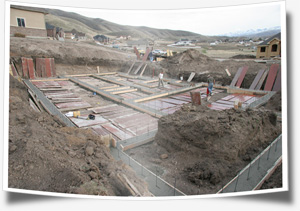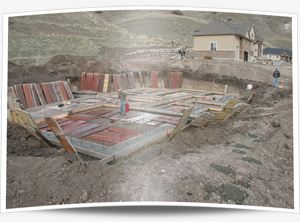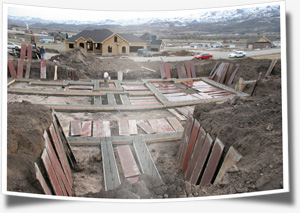Footings
The footings contractor jumped onto the job site right away, with only a weekend between him and the excavator. In our case, the footings contractor is also the foundation contractor. This is probably the case in most jobs where the foundation walls are poured concrete.
They moved very quickly setting stakes and running string lines to indicate the location of the footings. Almost immediately he noticed a small oversight by the excavation contractor - he had forgotten to dig a spot for the basement door and stairs that lead to the back yard. It was not a big problem, but he had to bring the excavator back to the site to dig it out (see picture below).
After they set up the wood forms for the footings according to the string lines, they set the rebar and called the city building inspector to come take a look. The inspection did not take long, but you cannot pour any concrete until the building inspector signs off on the forms and the rebar.
The width of the footings generally depends on a few things - the type of soil (i.e. how hard it is), the type of house (two story or rambler), the material used on the exterior of your house (brick, stone, siding, etc.) and local building codes.
The footings don't just run around the perimeter of the house - they also are run through the house in places where major load bearing walls will go, and other load bearing elements, such as walls around a staircase.
The process of getting the footings done really moves quickly - typically they set the forms and rebar in one day, and pour the next, provided the inspector is able get out to the site right away.
Although there is nothing very exciting to write about the footings, they are an absolutely crucial part of construction. They set the tone for the rest of the project. If your footings are not square and parallel, it will make it much more difficult to set the foundation walls correctly, which will in turn make good framing more difficult.
I had assumed that the footings would have to cure for quite a few days before they could get started with the foundation. However, provided that the weather is dry, they can start working on setting the foundation wall forms the day after the footings are poured.


